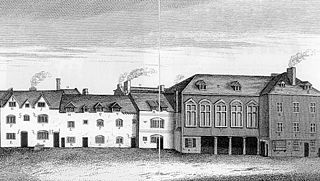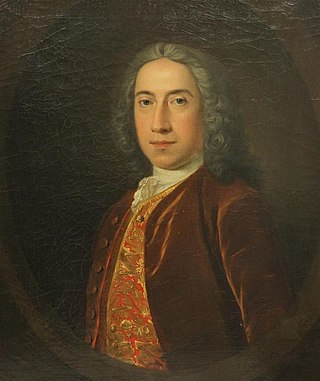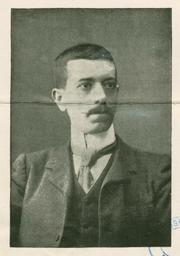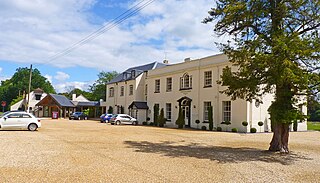
East Florida was a colony of Great Britain from 1763 to 1783 and a province of the Spanish Empire from 1783 to 1821. The British gained control over Spanish Florida in 1763 as part of the Treaty of Paris which ended the Seven Years' War. Deciding that the colony was too large to administer as a single unit, British officials divided Florida into two colonies separated by the Apalachicola River; the colony of East Florida, with its capital located in St. Augustine and West Florida with its capital located in Pensacola. East Florida was much larger and comprised the bulk of the former Spanish colony and most of the current state of Florida. It had also been the most populated region of Spanish Florida, but before control was transferred to Britain, most residents – including virtually everyone in St. Augustine – left the territory, with most migrating to Cuba.

James Grant, 4th of Ballindalloch (1720–1806) was a British Army officer who served as a major general during the American War of Independence. He served as Governor of East Florida from 1763 to 1771, and between 1773 and 1802 he had seats in the House of Commons.

Patrick Tonyn (1725–1804) was a British General who served as the last British governor of East Florida, from 1774 to 1783. His governorship lasted the span of the American Revolution. East Florida was a Loyalist colony during the war.
The Natchez District was one of two areas established in the Kingdom of Great Britain's West Florida colony during the 1770s – the other being the Tombigbee District. The first Anglo settlers in the district came primarily from other parts of British America. The district was recognized to be the area east of the Mississippi River from Bayou Sara in the south and Bayou Pierre in the north.

Amelia Island is a part of the Sea Islands chain that stretches along the East Coast of the United States from South Carolina to Florida; it is the southernmost of the Sea Islands, and the northernmost of the barrier islands on Florida's Atlantic coast. Lying in Nassau County, Florida, it is 13 miles (21 km) long and approximately 4 miles (6.4 km) wide at its widest point. The communities of Fernandina Beach, Amelia City, and American Beach are located on the island.

The colonial period of South Carolina saw the exploration and colonization of the region by European colonists during the early modern period, eventually resulting in the establishment of the Province of Carolina by English settlers in 1663, which was then divided to create the Province of South Carolina in 1710. European settlement in the region of modern-day South Carolina began on a large scale after 1651, when frontiersmen from the English colony of Virginia began to settle in the northern half of the region, while the southern half saw the immigration of plantation owners from Barbados, who established slave plantations which cultivated cash crops such as tobacco, cotton, rice and indigo.

The Marshalsea Court was a court associated with the Royal Household in England. Associated with, but distinct from, the Marshalsea Court was the Palace Court.
Andrew Turnbull was a Scottish physician and diplomat who served as the British consul at Smyrna, Ottoman Empire. In 1768, he founded the colony of New Smyrna, Florida, named in honor of his wife's birthplace, the ancient Greek city of Smyrna on the Aegean coast of Anatolia. Turnbull was married to Gracia Dura Bin, the daughter of a Greek merchant from Smyrna. His colony was located in the province of British East Florida, and encompassed some 101,400 acres (410 km2); it was nearly three times the size of the colony at Jamestown.
Colonel Sir Thomas Modyford, 1st Baronet was a planter of Barbados and Governor of Jamaica from 1664 to 1671.

Levett is a surname of Anglo-Norman origin, deriving from [de] Livet, which is held particularly by families and individuals resident in England and British Commonwealth territories.

Captain Christopher Levett was an English writer, explorer and naval captain, born at York, England. He explored the coast of New England and secured a grant from the king to settle present-day Portland, Maine, the first European to do so. Levett left behind a group of settlers at his Maine plantation in Casco Bay, but they were never heard from again. Their fate is unknown. As a member of the Plymouth Council for New England, Levett was named the Governor of Plymouth in 1623 and a close adviser to Capt. Robert Gorges in his attempt to found an early English colony at Weymouth, Massachusetts, which also failed. Levett was also named an early governor of Virginia in 1628, according to Parliamentary records at Whitehall.

Richard Oswald was a Scottish merchant, slave trader and diplomat. During the American Revolution, he served as an advisor to the North ministry on trade regulations and the best way to respond to the American War of Independence. Oswald is best known for being one of the British peace commissioners who negotiated the Peace of Paris in 1782.
Francis Levett (1654–1705) was a Turkey Merchant of the City of London who in partnership with his brother Sir Richard Levett, Lord Mayor of London, built a trading empire, importing and distributing tobacco and other commodities, mainly from the Levant. He served as Warden of the Worshipful Company of Mercers.

Sir Richard Levett was an English merchant, politician and slave trader who served as Lord Mayor of London in 1699. Born in Ashwell, Rutland, he moved to London and established a pioneering mercantile career, becoming involved with the Bank of England and the East India Company. Levett was acquainted with many prominent individuals during his time in London, among them Samuel Pepys, John Houblon, William Gore, Sir John Holt, Robert Hooke, and Charles Eyre. He acquired several properties in Kew and Cripplegate.

Sidney Kilner Levett-Yeats, an English novelist known professionally as S. Levett-Yeats, was the descendant of an old English trading family with connections to British India. S. Levett-Yeats became a soldier with the Indian Army and later joined the Indian Civil Service as a low-level bureaucrat. Inspired by the example of other ambitious Anglo-Indian writers like Rudyard Kipling, Levett-Yeats turned out a series of Victorian potboilers, often set in Europe, that earned him a place on the bestseller lists of the day.
Rev. Ralph Levett was an English Anglican minister who served as domestic chaplain to an aristocratic family from Lincolnshire with Puritan sympathies, who subsequently installed him as rector of a local parish. A graduate of Christ's College, Cambridge, where he became a protégé of the prominent Puritan minister John Cotton, Levett later married the sister of the wife of his friend Rev. John Wheelwright, another well-known early Puritan settler of New England.

Stephen Duncan was an American planter and banker in Mississippi. He was born and studied medicine in Pennsylvania, but moved to Natchez District, Mississippi Territory in 1808 and became the wealthiest cotton planter and the second-largest slave owner in the United States with over 2,200 slaves. He owned 15 cotton and sugar plantations, served as President of the Bank of Mississippi, and held major investments in railroads and lumber.

East Close House in Hinton, Hampshire, near Christchurch, Dorset, is a building of historical significance and a grade II listed building on the English Heritage Register. A mansion house stood on the site by 1742, which may be that crudely illustrated on Taylor's Hampshire map of 1759. Many notable people resided here before its conversion to a hotel in the 1930s. It was announced in August 2018 that the hotel would close later in the year.

Francis Philip Fatio, born in Switzerland, was a soldier for France, a viscount in Sardinia, a merchant in London, and a prominent planter in East Florida during both the British period and the second Spanish period.
Judith Philip was a free, Afro-Grenadian business woman who amassed one of the largest estates in Grenada. By the time Britain emancipated slaves in the West Indies she owned 275 slaves and was compensated 6,603 pounds sterling, one of the largest settlements in the colony.















